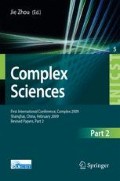Abstract
Crowd stampedes and evacuation induced by panic caused by emergences often lead to fatalities as people are crushed, injured, trampled or even dead. Such phenomena may be triggered in life-threatening situations such as fires, explosions in crowded buildings. Emergency evacuation simulation has recently attracted the interest of a rapidly increasing number of scientists. This paper presents an Agent-Based Modeling and Simulation using Repast software to construct crowd evacuations for emergency response from an area under a fire. Various types of agents and different attributes of agents are designed in contrast to traditional modeling. The attributes that govern the characteristics of the people are studied and tested by iterative simulations. Simulations are also conducted to demonstrate the effect of various parameters of agents. Some interesting results were observed such as "faster is slower" and the ignorance of available exits. At last, simulation results suggest practical ways of minimizing the harmful consequences of such events and the existence of an optimal escape strategy.
Access this chapter
Tax calculation will be finalised at checkout
Purchases are for personal use only
Preview
Unable to display preview. Download preview PDF.
References
Bonabeau, E.: Agent-based modeling: Methods and techniques for simulating human systems. Proceedings of the National Academy of Sciences of the United States of America 99, 7280–7287 (2002)
Pelechano, N., Malkawi, A.: Evacuation Simulation Models: Challenges in Modeling High Rise Building Evacuation With Cellular Automata Approaches. Automation in construction 17(4), 377–385 (2008)
Glen, I.F., Galea, E.R., Kiefer Kevin, C.: Ship evacuation simulation: Challenges and solutions, Discussion. Society of Naval Architects and Marine Engineers 109, 121–139 (2001)
Neumann, C., Neunteufel, R.J.: Evacuation Simulation at Linz Central Station–Usefulness during design, approval and start-up. Pedestrian and Evacuation Dynamics, pp. 333–339 (2005)
Park, H., Kim, H., Whang, H., Park, J., Lee, D.: Development of an Agent-based Behavior Module for Evacuation Models — Focused on the Behaviors in the Dark. Pedestrian and Evacuation Dynamics, pp. 347–356 (2005)
Christensen, K., Sasaki, Y.: Agent-Based Emergency Evacuation Simulation with Individuals with Disabilities in the Population. Journal of Artificial Societies and Social Simulation 11(3), 9–21 (2008)
Santos, G., Aguirre, B.E.: A Critical Review of Emergency Evacuation Simulation Models. In: Workshop on Building Occupant Movement during Fire Emergencies, pp. 25–50 (2004)
Bowen Loftin, R., Petty, M.D., Gaskins III, R.C., McKenzie, F.D.: Modeling Crowd Behavior for Military Simulation Applications. Organizational Simulation, 124–131 (2005)
Muhdi, R.A.: Evacuation Modeling: Development, Characteristic, and Limitations. In: Proceedings of the IEEE CEC, Vancouver, BC, Canada, pp. 87–92 (2006)
Fromm, J.: The Emergence of Complexity. Kassel university press, GmbH, Kassel (2004)
Wolfram, S.: A new kind of science. Wolfram Media, Inc. (2002)
Wooldridge, M.: An introduction to multiagent systems. John Wiley & Sons, Inc., Chichester (2002)
Weiss, G.: Multiagent systems: a modern approach to distributed artificial intelligence. MIT Press, Cambridge (1999)
Flake, G.W.: The computational beauty of nature. MIT Press, Cambridge (1998)
Ji, Q., Gao, C.: Simulating Crowd Evacuation with a Leader-Follower Model. International Journal of Computer Sciences and Engineering Systems 1(4), 27–30 (2007)
Murakami, Y., Minami, K., Kawasoe, T., Ishida, T.: Multi-Agent Simulation for Crisis Management. In: Proceedings of the IEEE Workshop on Knowledge Media Networking, Washington DC, USA, pp. 135–139 (2002)
Helbing, D.: Agent-Based Simulation of Traffic Jams, Crowds, and Supply Networks. In: Proceeding of the IMA ‘Hot Topics’ Workshop, IMA, Minneapolis, MN, pp. 213–223 (2003)
Kota, R., Bansal, V., Karlapalem, K.: System Issues in Crowd Simulation using Massively Multi-Agent Systems. In: Workshop on Massively Multi Agent Systems, pp. 251–257 (2006)
Lightfoot, T.J., Milne, G.J.: Modeling Emergent Crowd Behavior. In: Proc. of the 1st Australian Conf. on Artificial Life, Canberra (2003)
Helbing, D., Farkas, I.J., Molnar, P., Vicsek, T.: Simulation of pedestrian crowds in normal and evacuation situations. In: Pedestrian and Evacuation Dynamics, pp. 21–58. Springer, Berlin (2001)
Chamlet, L.G., Francis, Saunders: Network Models for Building evacuation. Management Science 28(1), 86–105 (1982)
Choi, W., Hamacher, Tufecki: Modeling of Building Evacuation Problems by network flows with side constraints. European Journal of Operational Research 35, 98–110 (1988)
Choi, W., Francis, Hamacher, Tufecki: Network Models of Building Evacuation Problems with Flow Dependent Exit Capacities. Operational Research, 1047–1059 (1984)
Lovas, G.G.: On the Importance of Building Evacuation System Components. IEEE Transactions on Engineering Management 45(2), 181–191 (1998)
Helbing, D., Farkas, I., Vicsek, T.: Simulating dynamical features of escape panic. Nature 407, 487–490 (2000)
Macal, C.M., North, M.J.: Agent-Based Modeling and Simulation: Desktop ABMS. In: Proceedings of the 2007 Winter Simulation Conference, USA, pp. 95–106 (2007)
Sugiman, T., Misumi, J.: Development of a New Evacuation Method for Emergencies: Control of Collective Behavior by Emergent Small Groups. Journal of Applied Psychology 73(1), 3–10 (1988)
Shendarkar, A., Vasudevan, K.: Crowd Simulation for emergency Response using BDI Agent Based on Virtual Reality. In: Proceedings of the 2006 Winter Simulation Conference, Monterey, California, USA, pp. 545–553 (2006)
Peer-Olaf, S., Aickelin, U., Celia, H., Clegg, C.: A Multi-Agent Simulation of Retail Management Practices. In: SCSC 2007, pp. 959–966 (2007)
Simon, H.A.: The Sciences of the Artificial, 3rd edn. MIT Press, Cambridge (1996)
Borshchev, A., Filippov, A.: From System Dynamics and Discrete Event to Practical Agent Based Modeling: Reasons, Techniques, Tools. In: Proceedings of the 22nd International Conference of the System Dynamics Society, Oxford, England, pp. 25–29 (July 2004)
Epstein, J.M., Axtell, R.: Growing Artificial Societies: Social Science from the Bottom Up. MIT Press, Cambridge (1996)
Author information
Authors and Affiliations
Editor information
Editors and Affiliations
Rights and permissions
Copyright information
© 2009 ICST Institute for Computer Science, Social Informatics and Telecommunications Engineering
About this paper
Cite this paper
Ren, C., Yang, C., Jin, S. (2009). Agent-Based Modeling and Simulation on Emergency Evacuation. In: Zhou, J. (eds) Complex Sciences. Complex 2009. Lecture Notes of the Institute for Computer Sciences, Social Informatics and Telecommunications Engineering, vol 5. Springer, Berlin, Heidelberg. https://doi.org/10.1007/978-3-642-02469-6_25
Download citation
DOI: https://doi.org/10.1007/978-3-642-02469-6_25
Publisher Name: Springer, Berlin, Heidelberg
Print ISBN: 978-3-642-02468-9
Online ISBN: 978-3-642-02469-6
eBook Packages: Computer ScienceComputer Science (R0)

